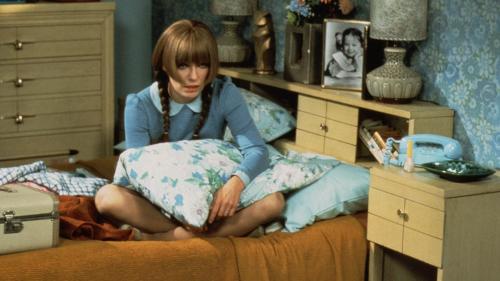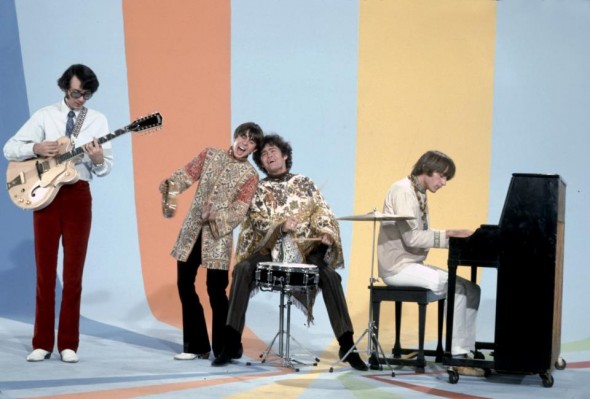As we wind up our series of “oddly wonderful” shows, we take a look at two shows that were set in the same community and may be two of the most unusual shows to ever air on television—Mary Hartman, Mary Hartman and Fernwood 2-Night.

If you read my blog often, you know I am not usually a fan of Norman Lear shows, and while these two series are very different from a typical Norman Lear show, unfortunately, I only enjoyed one of them. Lear’s shows were filmed at Metromedia Square in Hollywood. When he got ready to tackle these shows, there was no room left there. He arranged to rent space from KTLA which was across Fernwood Street. The staff started calling KTLA “Fernwood” which became the name of the town in Ohio where Mary lives.

Lear said he created the show to deal with consumerism.
The original show was was a campy show but had likable and thoughtful characters. Like Soap, this show had a brilliant cast and satirized soap series. It was called Mary Hartman, Mary Hartman, because the writers said dialogue on a soap opera was often said twice. Lear filmed the pilot and offered it to the three major networks who all passed. The show began as a syndicated show (it began on 50 stations) and was only on from January 1976 till May 1977. Unlike Soap, this show produced a huge number of episodes, 325 to be exact. It aired daily on weekdays.
Like the Tates and Campbells, Mary suffered through bizarre plots and unbelievable story lines, including adultery, mass murder, disease, homosexuality, religious cults, UFO sightings, and a nervous breakdown.

Dodie Goodman as Martha
Louise Lasser (who had been married to Woody Allen) portrayed Mary. She was married to Tom (Greg Mullavey). Tom worked at an auto assembly plant. Dody Goodman played Mary’s mother Martha. Debralee Scott played her sister Lorraine. The cast was rounded out by amazing supporting characters including Mary Kay Place as Mary’s best friend Loretta; Graham Jarvis as Charlie, Loretta’s husband and Tom’s best friend; Claudia Lamb as Heather, Mary and Tom’s daughter; Martin Mull as Garth Gimble who killed his wife; Dabney Coleman, Fernwood’s mayor; Gloria DeHaven who had an affair with Tom; Orson Bean as Rev. Brim, Shelley Fabares as Eleanor Major, a woman Tom falls in love with after Mary leaves him; Ed Begley Jr. as Steve; and Doris Roberts as Dorelda Doremus, a faith healer.

Mary Kay Place as Loretta
Mary wore her hair in braids like Pippi Longstocking. One article described her as a life-size Raggedy Ann. She was indecisive and switched her emotions quickly and without reason. Mary went through one crisis after another until she couldn’t function anymore. One of the things that led to Mary’s breakdown was that she believed everything she saw on television and it made her crazy that she could not see the waxy yellow build up the commercials claimed was on her floor. She was also dealing with marital problems and boredom.

Right from the beginning, the show displayed its weird story lines. In the first episode, the Lombardi family of five is murdered and the neighborhood tries to catch the Fernwood Flasher, who later turned out to be Mary’s grandfather. There were a lot of strange deaths in this show. Jimmy Joe Jeeter was electrocuted in the tub, Coach Leroy drowned in chicken noodle soup, and Garth Gimble impaled his wife on a bottle brush Christmas tree.
In 1977, Lasser decided to leave the show. The rest of the cast continued on and accounted for her disappearance by announcing that she had run off with Sgt Dennis Foley. The show then became Forever Fernwood.

Later that year, Fernwood 2-Night was spun off. Martin Mull was now Garth’s twin brother Barth and was the host of a late-night talk show with Jerry Hubbard (Fred Willard) as his “Ed McMahon”.
One of my favorite things about this show was Frank DeVol, the composer, who played Happy Kyne with his band the Mirth Makers (Eddie Robertson, Tommy Tedesco, Frank Marocco, and Colin Bailey) on the show. Happy never looked happy; he had a side business, a fast-food restaurant called Bun ‘n Run.

Alan Thicke was the head writer on the show. Lear thought it should all be improvised, but Thicke said it needed a balance of scripting with ad-lib.
In the same way Mary Hartman satirized soap operas, this show satirized late-night talk shows. The guests were a mix of real and fictional people. For example, Tom Waits appeared on the show when his bus broke down in Fernwood. I don’t remember a lot about this show specifically, but I remember thinking it was very funny.

After the first season, the show was moved to California where celebrities would be more likely to appear on the show.

I have never seen either of these shows in reruns and like most of the shows we learned about this month, I think they are better left as a remnant of the era they debuted in. Although few people seem to remember Mary Hartman, Mary Hartman, it was listed #21 on TV Guide’s list of best one-hundred shows in 2003. When thinking about the classic shows that had been on the air by 2003, that says a lot about what TV Guide thought about the quality of this show.
Lear had to tow a fine line on this show. With the types of crises Mary encountered and the bleak life that was portrayed of a housewife in Fernwood, Ohio, it was close to tragic. The exaggerated number of catastrophes and despairing situations kept it slightly in the humor genre. The demise of the show is often blamed on Lasser’s leaving, but in my opinion, it could not have continued to sustain viewers much longer than it was on the air. How many crises can be cooked up that hadn’t happened, and when did the tragic overtake the comedy for most viewers? Again, it’s a show best viewed in its decade.
In my rating of odd, wonderful, or oddly wonderful, I give Fernwood 2-night wonderful, and I’m afraid I have to give Mary Hartman an odd rating. It was a hard show to watch. If you wanted drama, there was too much humor in it, but if you wanted comedy, it was way too dark. I’d love to hear from you on your ratings for these two little-remembered shows.












































